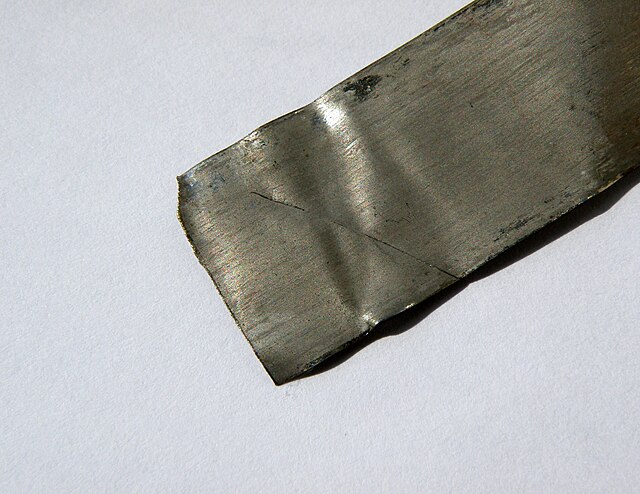Permalloy is a nickel–iron magnetic alloy, with about 80% nickel and 20% iron content. Invented in 1914 by physicist Gustav Elmen at Bell Telephone Laboratories, it is notable for its very high magnetic permeability, which makes it useful as a magnetic core material in electrical and electronic equipment, and also in magnetic shielding to block magnetic fields. Commercial permalloy alloys typically have relative permeability of around 100,000, compared to several thousand for ordinary steel.
Strip of permalloy
Nickel is a chemical element; it has symbol Ni and atomic number 28. It is a silvery-white lustrous metal with a slight golden tinge. Nickel is a hard and ductile transition metal. Pure nickel is chemically reactive, but large pieces are slow to react with air under standard conditions because a passivation layer of nickel oxide forms on the surface that prevents further corrosion. Even so, pure native nickel is found in Earth's crust only in tiny amounts, usually in ultramafic rocks, and in the interiors of larger nickel–iron meteorites that were not exposed to oxygen when outside Earth's atmosphere.
Nickel
Electron micrograph of a Ni nanocrystal inside a single wall carbon nanotube; scale bar 5 nm
Widmanstätten pattern showing the two forms of nickel–iron, kamacite and taenite, in an octahedrite meteorite
Color of various Ni(II) complexes in aqueous solution. From left to right, [Ni(NH3)6]2+, [Ni(NH2CH2CH2NH2)]2+, [NiCl4]2−, [Ni(H2O)6]2+





![Color of various Ni(II) complexes in aqueous solution. From left to right, [Ni(NH3)6]2+, [Ni(NH2CH2CH2NH2)]2+, [NiCl4]2−, [Ni(H2O)6]2+](https://upload.wikimedia.org/wikipedia/commons/thumb/f/ff/Color_of_various_Ni%28II%29_complexes_in_aqueous_solution.jpg/640px-Color_of_various_Ni%28II%29_complexes_in_aqueous_solution.jpg)